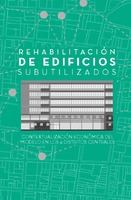Mostrar el registro sencillo del ítem
Rehabilitación de edificios subutilizados : contextualización económica del modelo en 4 distritos centrales
| dc.contributor.advisor | Orozco-Muñoz, Sebastián | es |
| dc.contributor.author | Rojas-Corella, Verónica | |
| dc.date.accessioned | 2017-05-10T17:55:33Z | |
| dc.date.available | 2017-05-10T17:55:33Z | |
| dc.date.issued | 2016 | |
| dc.identifier.uri | https://hdl.handle.net/2238/7076 | |
| dc.description | Proyecto de graduación (Licenciatura en Arquitectura y Urbanismo) Instituto Tecnológico de Costa Rica, Escuela de Arquitectura y Urbanismo, 2016. | es |
| dc.description.abstract | La rehabilitación de edificios es un tema que por sí solo engloba otras líneas de investigación. Al hablar de la rehabilitación se cae en modelos urbanos de consenso mundial y en sostenibilidad. Por esto, se plantea que la investigación se realice en el centro de San José, donde se involucre una de sus mayores faltantes para lograr ser una capital más eficiente, por medio de la creación de edificaciones mixtas que incluyan vivienda. La búsqueda de esta aplicación local es para crear un modelo urbano que se encuentre en la agenda del gobierno local. Con el primer criterio claro, aparecen puntos clave para que funcione el proyecto a plantear: el edificio a usar, los usuarios (enfoque dirigido), las externalidades positivas y el ofrecer algo innovador. Sin embargo, sin obviar el tema de la sostenibilidad, la rehabilitación de una construcción a nivel teórico genera un 60% de ahorro con respecto con respecto a una demolición y una nueva edificación. Por tanto, surge la pregunta: ¿En el ámbito nacional, este ahorro es verdadero? La investigación busca hacer un análisis comparativo entre una rehabilitación y una demolición. Así como poder presentar datos de la factibilidad de la rehabilitación a promotores de la ciudad. | es |
| dc.description.abstract | Buldings refurbishment is an issue that alone encompasses other lines of reaserch. When we talk about refurbishment, it involves other subjects such like sustainability and global urban models. For this reason, it is proposed that the investigation be carried out in the middle of the Capital, San José, where one of its major problem it’s implicate, the necesity of housing projects. The search for this local application is to create an urban model that is on the agenda of local government. With the first criterion clear, key points appear for the project to work: the building to use, the users, the positive activities around and the offer something innovative. However, without neglecting the issue of sustainability, the rehabilitation of a construction at the theoretical level generates 60% savings with respect to a demolition and a new building. Therefore, the question arises: in the context of our city, is this saving true? The research seeks to make a comparative analysis between a rehabilitation and a demolition. As well as being able to present data of the feasibility of the rehabilitation to promoters of the city. | |
| dc.language.iso | spa | es |
| dc.publisher | Instituto Tecnológico de Costa Rica | es |
| dc.rights | acceso abierto | es |
| dc.subject | Tesis | es |
| dc.subject | Rehabilitación-Edificios | es |
| dc.subject | Rehabilitación urbana | es |
| dc.subject | Remodelaciones | es |
| dc.subject | Vivienda multifamiliar | es |
| dc.subject | Proyectos de graduación | es |
| dc.subject | Arquitectura | es |
| dc.subject | Research Subject Categories::TECHNOLOGY::Civil engineering and architecture::Architecture and architectural conservation and restoration::Architectural conservation and restoration | es |
| dc.subject | Renewal | |
| dc.subject | Buildings | |
| dc.subject | Urban renewal | |
| dc.subject | Multi-family housing | |
| dc.subject | Architecture | |
| dc.title | Rehabilitación de edificios subutilizados : contextualización económica del modelo en 4 distritos centrales | es |
| dc.type | proyecto fin de carrera | es |


